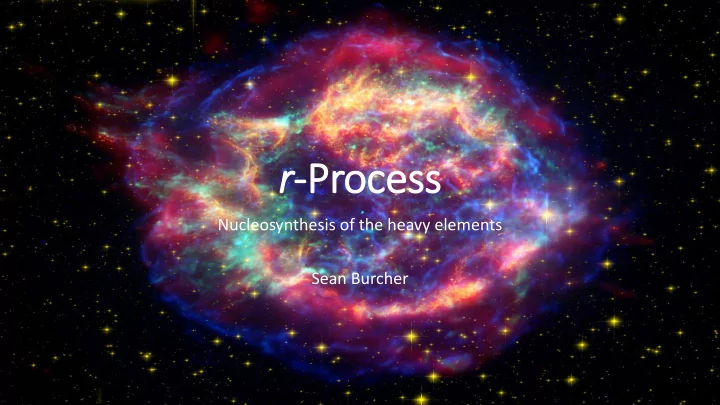

r -Process Nucleosynthesis of the heavy elements Sean Burcher
What is r -Process • Rapid neutron capture • The dominant process through which elements heavier than iron are formed (also s-process or slow neutron capture) • The exact site of r-process is still unconfirmed however due to the conditions necessary (high neutron density, high temperature) core collapse supernovae and neutron star mergers are the most likely candidates.
Chart of f Nuclides
Mechanisms of r-process • High T (T > 10 9 K) • High neutron density (n n > 10 22 cm -3 ) • Nuclei are bombarded with neutrons. • Neutrons can be absorbed until the neutron separation energy is less than or equal to zero. This is the Neutron drip line. • Neutron rich isotopes are unstable to beta decay. • After beta decay the new nucleus will have a new neutron drip line and in most cases be able to capture more neutrons.
(n, γ ) and ( γ ,n) Equilibrium • Photodisintegration can play an important role in the r-process path. In very these hot environments there will be high energy photons. • The location of “waiting points” in r -process are points where an equilibrium between neutron capture rates and photodisintegration has been reached.
(n, γ ) and ( γ ,n) Equilibrium • Start with stable “seed” nucleus (A,Z) ( A , Z ) + n → ( A+1 , Z ) + n → ( A+2 , Z ) + n … ( A+i , Z) • The more neutron rich the nuclei become • (n, γ ) cross section goes down • ( γ ,n) cross section goes up • When the rates for (n, γ ) are equal to the rates for ( γ ,n) equilibrium is reached. This nucleus would be ( A+i , Z) where i is the number of neutrons captured. • At this equilibrium point the nuclei can beta decay ( A+i , Z) → ( A+i , Z+1)
r-process vs. s-process • If the neutron capture rates are low enough then nuclei have time to beta decay before being hit by another neutron (s-process) • If the neutron capture rates are high then once an equilibrium between neutron capture and photodisintegration has been reached beta decay will occur. Kenneth Krane, Introductory Nuclear Physics , (1987)
Shell closures • Analogous to electron shell closures in atoms. There are certain numbers of nucleons that form particularly stable nuclei. These are known as magic numbers and magic nuclei. • At neutron shell closures the rates for (n, γ ) decrease and nuclei are able to live long enough to beta decay. • Just past the shell closure ( γ ,n) rates are very large. • After beta decay the nucleus will capture another neutron and once again be at a neutron shell closure.
Shell closures and Abundance • As a result of the r process path waiting at shell closures the abundance of nuclei in the corresponding mass range is increased. Clayton, Principles of Stellar Evolution and Nucleosynthesis , (1983)
r-process vs. s-process abundances Kenneth Krane, Introductory Nuclear Physics , (1987)
The end of r-process: Fission • Eventually it is impossible to make a bigger nucleus. Trying to pack too many protons in a nucleus results in instability to spontaneous fission as well as neutron induced fission. • Nuclei in the N = 175 region typically fission and terminate the r-process. • The fission fragments from the heavy nucleus will re-seed the r-process
Modeling r-process • To understand the abundance of elements in the universe it is important that we understand r-process • Important parameters: neutron density, temperature, neutron capture cross sections, neutron magic numbers, beta decay half lives, and initial composition • Models of r process are used to try and reproduce the abundance of elements observed in the universe • Models are very sensitive to neutron capture cross sections and beta decay properties, both of which can be measured in the laboratory by nuclear physicists • Current models do not reproduce the observed abundance of elements in the universe
Challenges of study (n, γ ) in the Lab • We want to use accelerators to create nuclear reactions relevant to r- process. • The nuclei involved in r-process are very short-lived and therefore will decay on you during measurement. • We can however create radioactive ion beams of these short lived nuclei. • We cannot make a neutron target. (free neutrons are unstable) • Next best thing is a deuteron. (1 proton, 1 neutron) • To study (n, γ ) on short-lived nuclei, we create beams of the nuclei and accelerate them at deuterium targets and look for the reaction (d,p). This is the surrogate reaction technique. • The detection of an outgoing tells you the a neutron transfer reaction has taken place.
Recommend
More recommend